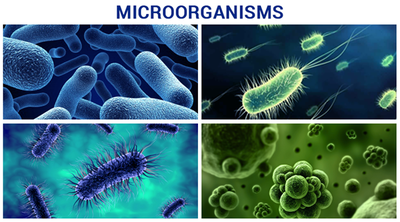Microorganisms
Definition

A microorganism is a form of life that can be single celled and can be formed in colonies of cells. These forms of life are almost all microscopic. The three main microorganisms are bacteria, fungi, and viruses. These microorganisms are extremely vital in everyday processes and especially in soil processes. [1]
Bacteria
A bacteria is a single celled microorganism or "microbe", that does not have a nucleus or any membrane bound organelles, therefore it is a Prokayote. The bacteria has a single loop of DNA which acts as the nucleus of the organism. Often there can be another strand of DNA that gives the bacteria a distinguishing feature that typically helps with survival. An example of this is the ability for some bacteria to be resistant to certain antibiotics, or some bacteria being able to survive in conditions with a higher pH than typical bacteria.
Bacteria reproduce by binary fission which means the single cell will split into two daughter (identical) cells, which then split into four, and so forth. Replication by binary fission is often a very fast process, but there are a few important steps involved.

Step 1: At the origin of previous replication, the strand of DNA begins to unravel and prepare for replication.
Step 2: The cell then elongates two prepare to slit and to contain both copies of the DNA.
Step 3: A septum forms down the center of the cell which is the start of the cell splitting. In this phase, the DNA migrate to each side of the cell.
Step 4: The septum continues down the entire cell and the cell splits into two identical cells. [2]
Bacteria is important to almost every soil process on the planet, which means that bacteria can survive in very harsh conditions; Whether it be in high temperatures, low temperatures, anoxic places, and areas in differing pH. A reason why bacteria is important to soils because they were one of the first organisms to begin decomposition of residues in the soil. Another and even more important role that bacteria fill is fixing nutrients for plant and other soil fauna uptake. Bacteria are responsible for dissolving phosphorus so that it is readily available for plants, and phosphorus is one of the key ingredients to a thriving plant. Also, bacteria fix nitrogen in the soil so that it is readily available to plants nearby. Plants and most other organisms are not able to utilize nitrogen gas (N2), but bacteria can use the nitrogen gas and convert it to a form that is beneficial for plant uptake. This is why you will find most bacteria in the rhizosphere where all of the plant roots typically are. [1]
References
[1] Nationwide, SARE. “Soil Microorganisms.” SARE: Sustainable Agriculture Research and Education, www.sare.org/Learning-Center/Books/Building-Soils-for-Better-Crops-3rd-Edition/Text-Version/The-Living-Soil/Soil-Microorganisms.
[2] “Bacterial Binary Fission.” Khanacademy, www.khanacademy.org/science/biology/cellular-molecular-biology/mitosis/a/bacterial-binary-fission.